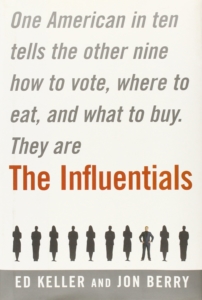
COVID-19 researchers have discovered superspreaders who can infect as many as 20 people with the virus. COVID-19 superspreaders are a lot like Influentials® who spread around usable advice freely that people welcome and trust.
According to Axios Science, three recent studies appear to indicate 10 percent of COVID-19 cases have led to 80 percent of new infections. Researchers say this reflects the “law of the vital few.” Influentials® represent about 10 percent of society as a whole and account for a disproportionate share of the advice that people seek and follow. You might call that another reflection of the law of the vital few.
So far, researchers have failed to pin down the genetic makeup or behavior patterns of superspreaders. They just know superspreaders are out there, adding to the COVID-19 caseload. Luckily, a different kind of researchers have figured out a way to identify an Influential based on their behavior patterns – well read, detail-oriented and willing to share what they know. There is plenty of empirical evidence that the advice of Influentials® is sought and valued.
Medical researchers also have identified superspreader events like indoor congregations of people at workplaces, nursing homes, prisons and churches. They say superspreader events magnify the infectious outreach of superspreaders, which can spark new outbreaks or send the virus off in unanticipated trajectories. Influentials® can have superspreader events such as blogs, speeches, classrooms and family get-togethers.

Obviously, identifying and tracking COVID-19 superspreaders is critical to controlling the virus until a vaccine is proven effective and safe. Just as obviously, it makes huge sense for communicators to identify and track Influentials® who could supercharge your messaging, whether it’s for marketing or issue management.
Influentials® can be identified within a larger random sample by asking certain demographic questions on a telephone or online survey. Their expressed views on a survey can often be interpreted as an “early majority” or a signpost to where informed people will head. One of the virtues of online surveys is that you can follow up with respondents based on their answers or identification as a group like Influentials®. These follow-up focus groups can yield greater insight into the thinking and trigger points of Influentials® – How do they evaluate a product or a political proposition? What factors tip them in one direction or another? Who do they trust for reliable information?
This level of understanding of how thoughtful people engage and form conclusions can prove invaluable in creating a customer journey, mounting a persuasive argument or informing a business decision. It also offers a clue of how to influence Influentials®, which can be a productive, very cost-effecting approach to superspreading your marketing or issue messaging.
Another approach is to turn to influencers. While distinct from Influentials®, influencers are people with large followings who depend on their advice for making purchases or life decisions ranging from makeup choices to mental health counseling. Reputable influencers act like third parties testing products, modeling behaviors or trying out new approaches. They have built-in audiences who pay attention to their findings and recommendations. Those findings and recommendations can attract media coverage, delivering an even wider audience.
An active, diversified social media presence can serve as a superspreader. Posts from or about Influentials® or reposts of influencer recommendations can spread the word to your existing audience and to potential new followers. This can earn your social media the reputation as an informative and influential resource in its own right.
Much like contact tracing for the coronavirus, marketeers and issue managers must search to find their respective audiences and understand their connection to their product or project. Influentials® can act as magnets drawing in people looking for trustworthy information and then serve as superspreaders for your message, triggering a word-of-mouth outbreak worthy of a virus.



